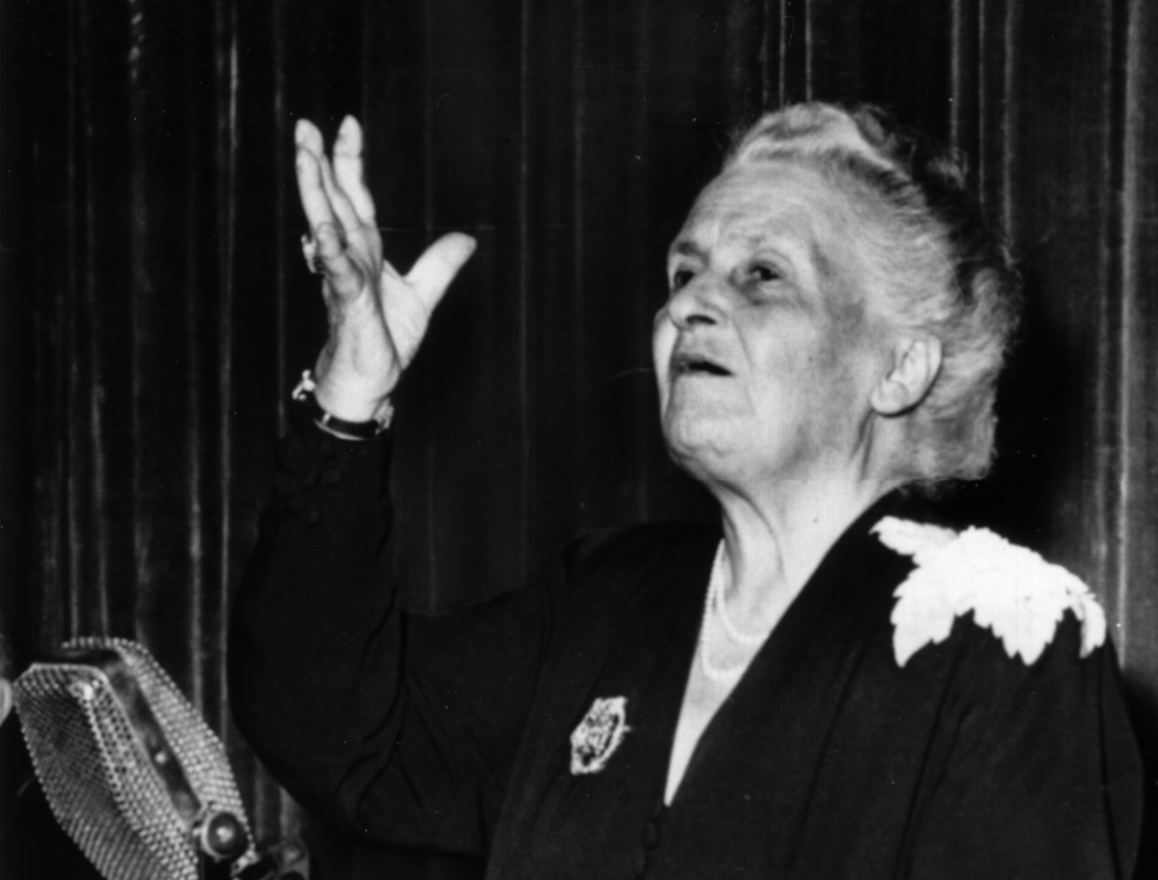Who Was Maria Montessori?

Dr. Maria Montessori has distinguished herself, in her lifetime, as a doctor, psychologist, scientist, educator, writer, activist and advocate for children worldwide.
Early Life and Family
Maria Tecla Artemesia Montessori was both a woman far ahead of her day yet, in a way, a true embodiment of her time: the Century of Discovery, a time when amazing new discoveries as well deep socio-political changes promised the advent of a new era of mankind and a true era of understanding.
Born in 1870 in Chiaravalle, Italy, Montessori’s own early life reflected these changes. Her mother, Renilde Stoppani, was a teacher in a modern invention which we would call today a company daycare: a school serving the employees (or rather, the children thereof) of the tobacco factory where Montessori’s father Alessandro worked.
Although Alessandro Montessori encouraged his daughter to pursue the seemlier career of a teacher, Renilde (herself well educated) supported her daughter’s ambition for academics. When the family moved to Rome, Montessori studied natural sciences and was intending to pursue a university degree in Engineering. Whilst there are differing accounts on what exactly made her switch to Medicine instead, it is certain that she had to apply a considerable strength of will and conviction to complete her training. She graduated from the University of Rome in 1896, as a Doctor of Medicine – one of the first female medical doctors in Europe.

Explore the fundamentals of Montessori parenting with this free video by Sylvia Arotin, offering insights and strategies to empower and educate your child.
Early Work – 1896 to 1906
To understand Dr. Montessori’s work, one must always bear in mind that first and foremost, she was a scientist. And as a scientist, she never really stopped being a student. After graduation, Dr. Montessori continued to further her education in anthropology and psychiatry, cultivated diverse scientific interests and maintained a lively correspondence with her contemporary academics. Throughout her life it is obvious that it was her powers of observation – and intelligently analyzing what she observed – that brought about her amazing discoveries: yet it would also be amiss to not realize she had never worked in a vacuum. Dr. Montessori remained clear and humble about the foundations her precursors laid out for her, and the influence of her many assistants, students and collaborators.
It is, in my opinion, equally important to consider Dr. Montessori’s identity as not only a scientist but as a human rights activist, tirelessly working to promote social justice and human rights – mainly women’s and children’s – and championing peace efforts. In 1896, the very year of her university graduation, she was invited as one of the speakers to the International Women’s Rights Congress in Berlin. Well regarded as an eloquent speaker, she continued to address various distinguished audiences throughout her life. Furthermore, she stated outright in her later writings that she regarded education as a path to social reform, bringing progress, peace and perhaps even a “higher form of civilization”.
Soon after graduation, Montessori began working at the University of Rome’s Hospital of Nervous Diseases. It was here that she first began working with developmentally delayed or impaired children, who occupied a ward of the mental hospital. Observing the children’s specific and peculiar behaviours, she concluded despite their delays that they were not mentally ill: the issues they faced were not psychiatric, but pedagogical, and she began working with them directly. At the same time, Montessori was studying the works of Jean Marc Itard and Edouard Segouin, French psychiatrists of the early and mid-19th century who worked with physically and mentally impaired children. Montessori greatly respected both, and adopted and advanced many aspects of their work; ultimately, she credited the men with the foundations of her later method. Improving on their work, she led many of her students to enter elementary schools, and her successes lead to the founding of the Scuola Magistrale Ortofrenica – the Ortophrenic School, intended to “correct” the education of students with special needs. However, if the disadvantaged children under her tutelage were surpassing their healthy peers, then what on Earth was wrong with the latter?
During this tumultuous time of study and travel, Maria’s son, Mario Montesano Montessori, was born in 1898. Maria never married his father and her colleague, Guiseppe Montesano, although, it is said, not for lack of him trying; however, marrying would have almost certainly ended her career. The relationship later collapsed, and Montessori opted to have Mario raised away from her, in the country, and continued her work. It wasn’t until fifteen years later that Mario joined his mother as a student and later partner. He however remained at her side for four decades of faithful collaboration, ended only by her death.
The Birth of the Montessori Method
As her work progressed, Montessori became more and more convinced that her methods were far superior to the public schools of her time, and of great benefit to all children. The issue then became acquiring a class of children to work with to prove this.
Fortunately for us (and perhaps sadly for the field of Anthropology, as Montessori was in the meantime named the Dean of Anthropology at the University of Rome), this class was found in the Rome district of San Lorenzo. Here, little children between the ages of three and six – whose mothers had to return to work but who were not yet old enough for school – were becoming something of a public nuisance. Perhaps the only reason that Montessori was given the go ahead on her “educational experiment” was to remove the very young vandals off the street. On January 6th, 1907, on the Feast of Epiphany, which is in Italy observed as a children’s feast, Montessori dedicated the first Casa dei Bambini: a “House of Children”.
The success of this early classroom, and the ones that followed, cannot be overstated. These Casas truly were experiments, with Montessori readily researching, adapting, implementing and improving ideas as the weeks and months progressed, learning far more from the children than they were from her (or rather, the environment she, together with her teachers and assistants, prepared). There were plenty of scrapped concepts alongside a number of happy accidents, which she all accepted, documented and credited with the grace and humility of a scientist deeply in love with her subject matter. Her writings from this period eventually became The Discovery of the Child, one of her best-known books.
The news of Montessori’s method and its accomplishments flew around the world. Montessori gained the respect of many influential and prominent figures in Europe and overseas, and no less acclaim at home. The first teacher training course in what became known as “the Montessori Method” opened in 1909, with several more to follow almost immediately; the first international course drew people from literally all over the world. An anecdotal account of two Australian sisters selling their house to afford to come illustrates the “Montessori fever” of the day. It seemed inevitable that the Montessori method would replace the traditional educational model in no time at all.
The Travelling Years
Much of the next two decades of Montessori’s life was spent travelling and spreading her method and philosophy throughout the world, always accompanied by her son Mario as a translator, collaborator and assistant. She was enthusiastically received in the United States, the United Kingdom and Spain, meeting or forming a correspondence with people such as Alexander Graham Bell, Mahatma Gandhi, President Woodrow Wilson, Sigmund and Anna Freud, or Helen Keller. However, despite the initial response, the Montessori movement didn’t take a firm root overseas. Facing many critics, most national organization fragmented and lost focus for years to come.
Meanwhile, the Montessori method in Italy was dealing with rather unwelcome attentions from a very influential fan and Montessori enthusiast: Benito Mussolini. His demands that the educational method adopts and spreads the ideals of fascism – and Montessori’s steadfast refusal to do so – eventually lead to backlash and forced closure of all Montessori schools in the country. Dr. Montessori herself was forced to leave her homeland, never to return.
India and the Later Years
The tumultuous political reality of the early twentieth century had, repeatedly, a tremendous influence on the spread of the Montessori method, and it is hard to resist spinning “what if” scenarios. In the eve of the Second World War, Montessori left for a six-week long trip to India, and ended up staying six years instead, stranded in an Ally-controlled country with an Axis-issued passport. Perhaps this was providential, protecting her away from the war torn Europe. Certainly, the Indian Montessori movement is one of the strongest in the world.
Just as Montessori never stopped studying, she also never stopped working. After her return to Europe, she continued to travel, lecture and teach; developed the Assistants to Infancy (for children from birth up to age three) and Elementary trainings, and published her definitive work on the first plane of human development, the Absorbent Mind. It was whilst busy planning for a journey to Africa when Montessori died of a brain hemorrhage at her daughter-in-law’s house in Holland. Amidst the many accolades she received in her lifetime, including three nominations for the Nobel Peace Prize, it is perhaps easiest to sum up her life’s work by quoting her grave’s inscription:
“I beg the dear and all powerful children to unite with me for the building of peace in Man and in the World.”
Montessori Beginnings
YOUR ULTIMATE
MONTESSORI PARENTING COURSE
FOR ZERO TO THREE
Gain clarity and confidence in your parenting to raise a resilient, independent and joyful child.


